October 2019 Wrapup!
And with that, spooky month draws to a close! Well, then, what happened during?
This month’s blog posts had a sort of mini-event feel to it. I’d planned to play some horror videogames and watch some horror movies and mostly found myself unhappy with the results, but I did get to finally put my thoughts out there on the fantastically terrifying Tickled.
I did a series of posts about me and my own experiences with trauma; stories about the first time I drowned, stories about the histories of serial killers and stories about the relationship I have to horror. Most importantly, though there was my reflection on the way ‘God’s Vengeance’ is more horrible and horrifying than anything a reasonable person would conceive of.
In other, lighter news, two different 4E posts went up and got a great reaction, one about running it, and one about making horror movie characters as D&D heroes.
I didn’t wind up making a deep dive video about Bloodborne. I think that I can still turn this article into a video, maybe for greater access, but the footage of Bloodborne I tried to record off my PS4 just wasn’t available, so that was a bummer. In the end, though, I feel that the article is really good in no small part because I think it’s worth calling out the way that games are forgiven their sins if they are deemed to have Proper Goodness.
Also, I finally sat down and told the story of Acephale in a way that’s suitably creepy!
After the blog posts, though we had my video on Blood, which was fun to record and also pretty quick. I like making these videos about games as I play them, with a certain degree of freedom to discuss. I think that I’d like to maybe try doing them on-and-off.
I’m also finding I have more video ideas than I have video article ideas. I’ll deal with the way the scheduling works in the new year, but for now there may be a bit more casual chat game videos coming up.
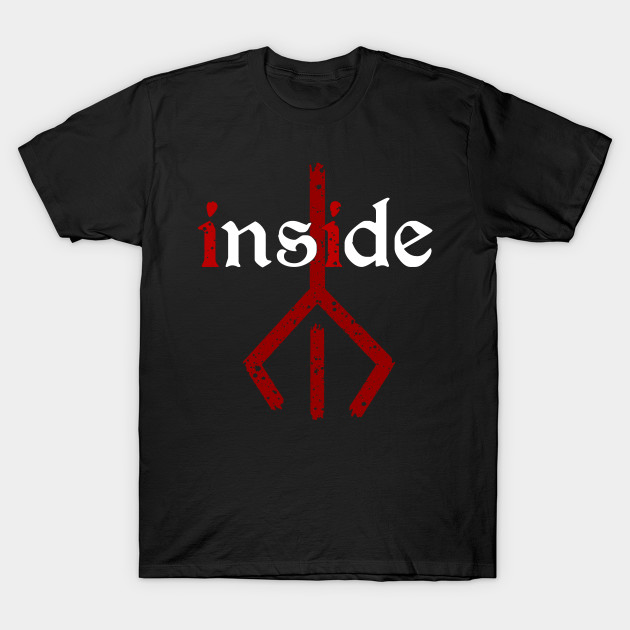
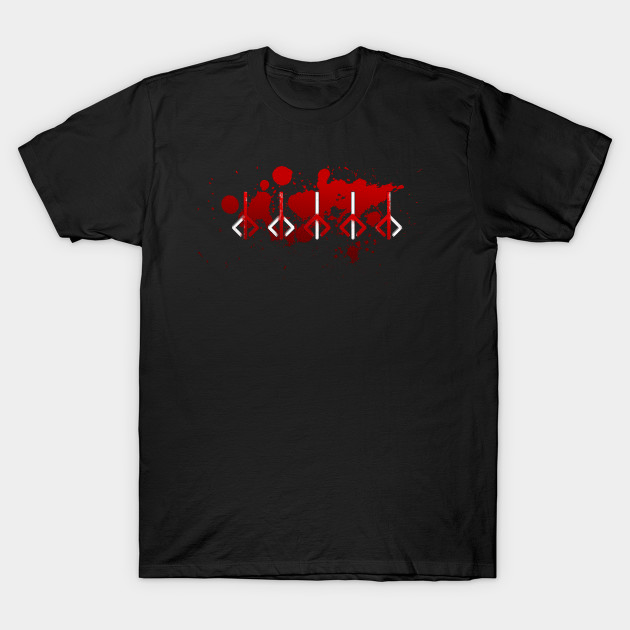
T-shirts! I made a pair of spooky designs for November, both based on the Hunter’s Mark from Bloodborne. I like them! The Hunter’s Mark is one of those bits of iconography I love from games and I really appreciate the subtle joke of ‘I’s in the ‘Inside’ being marked differently.
Games we didn’t get tons of work done on! I did a bunch of playtesting of games I had already underway, but this month has been heavily focused on teaching, which means a lot of my creative time is spent exploring things that my students might be interested in, so I can meaningfully comment on it.
And finally, personally? I have felt really tired and groggy this October, which means a lot of work I’d have gotten done just melted away in hours of playing picross in bed while I tried to muster the energy to stand up.
Hunter’s Dreams – Defining the Hunt
This is more work on Hunter’s Dream, a 4th Edition D&D-compatible mod made to enable a Bloodborne style of game, where players take on the role of hunters, who have to first research their prey before going out to the tactical combat stage of things where players get to have cool fights with werewolves and whatnot.
Something I really like from Blades in the Dark, something that I am shamelessly trying to bring to Dungeons & Dragons 4th Edition in Hunter’s Dream, is the degree to which players have a sense of agency over the game they’re engaging with.
There’s an existing mindset for D&D that games are basically one of two different kinds of play space. The first is often known as narrativist, where you treat every session, every encounter, as a sequence in a narrative, and so the whole game can be seen as a string of beads. This vision can be sometimes presented as a weakness, where the players are always confined by ‘the story’ that wraps around them like a tunnel. I’m not really here to criticise that, because hey, even the most railroaded game campaign can still be an interesting ghost train.
Then there’s a position, often called ‘simulationist’ which presents the idea that the players are just operating in a world, there’s stuff for them to do, and they can go do stuff at that world, and if it does all relate or connect to things, that’s just because the DM’s job is ‘running the world,’ and any narrative that ensues is emergent. I don’t think this is true either, but some people are fond of talking about it like that.
Neither of these perspectives suit well Blades in the Dark‘s style of player-driven fiction roleplay, and they don’t quite do the job of what I want for Hunter’s Dream. What I want for this is a hybrid model, with a Narrative running as a timer on a simulation, and a large part of that is formalising a system whereby players have direct agency over the tasks in front of them, and the order they handle them.
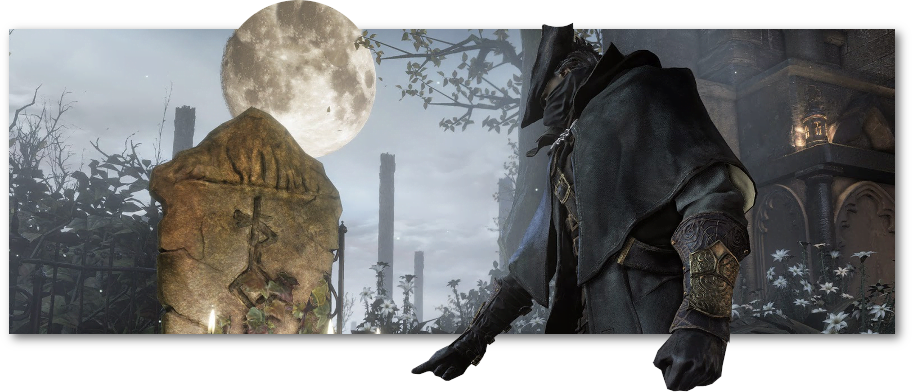
Now, 4ed is good for this because 4ed D&D is designed to handle a lot of small tactical encounters that are reasonably well-balanced with one another, where the alchemy between monster interactions are less likely to result in catastrophic failures. You’re not likely to find a lot of total dealbreaker combos if you throw enemies together semi-randomly, which means one of the things that it handles really well is generating sequences of small quantities of conflict without necessarily a lot of elaborate construction.
This asks for a robust system for constructing incidents quickly, giving DMs good sources of inspiration, and a clear vision of how they can execute on these encounters interestingly. Now I’m a sucker for this: In 4e, I’m a fan of using the same monster configurations from fight to fight and just changing the terrain around them and watching as players have to formulate different strategies to deal with them.
What I think of in Hunter’s Dream then is that players have a set of different competing needs, they choose what they’re going to go out and hunt, and why. This isn’t to leave players completely adrift, stuffing their characters into a monster pachinko machine – if you’re fighting random monsters of your level, over and over, you’re just going to feel like you’re throwing effort into a bin. What you need then is stuff to structure the kinds of encounters players are after, which I divide into four basic categories: Incidents, Schemes, Needs, and The Doom.
Continue Reading →the miserable vegeance of a cruel god
Content Warning: I discuss dealing with abusers, violence, and tragedy. This one sucks. Trust me, it’s not a fun time.
Continue Reading →Story Pile: Tickled
This is one of the scariest fucking things that you’ll ever see.
Halloween As an ASMR Fan
ASMR is a subculture that’s full of people who like to dress up for a camera. Well I assume they like to dress up, I don’t know if it’s actually a thing they enjoy but at least for now I’d like to imagine they’re doing something they enjoy.
Typically any given description of ASMR is going to involve a description of what the phenomenon is, so here we go: ASMR is an acronym you don’t need to remember for an ill defined ‘response’ some people can get from a range of subtle positive stimuli. Typically but not always, ASMR effects are described as ‘tingling’ along the line of the skull, and can be brought on by specific sounds or groups of sounds with slight variation in the stimuli. As an example, earlier this year, a channel I follow – and like, totally unironically – released a forty minute video of someone wordlessly filling a bucket with soda and ice and gently stirring so I could listen to the clinking of ice and the bubbles of the soda.
ASMR tends to also be connected to some awkward things. For example, ‘trigger’ is a very common word in ASMR communities, and there it’s used unironically and positively to describe something that causes the reaction, so you can get something described as ‘very triggery’ or ‘totally triggered’ which isn’t meant to be a jerkhole’s way of describing someone being upset or bothered by something.
I do experience ASMR, and I use ASMR videos to listen to as background to study and to help me overcome the difficulty of wakefulness that I have. Sometimes I use it when I’m travelling on a bus to help fight carsickness. It’s a whole online cultural space.
ASMR has trends, too; what I listen to is largely on Youtube, which means it is largely driven by the algorithm. Some channels are large enough to have support and sponsors like the familiar podcast supporters, including beds and anime, and that means you get ASMR video trends that tie into sponsors trying out the space. That sometimes means a bunch of anime characters will whisper to you and help you build your costume or your arm or whatever the current in series is. The culture sways to the algorithms of our society.
Around Halloween there’s a pretty easy theme and lots of people play into it:

One other weird thing is that Youtube specifically demonitises videos that are marked as ‘roleplay’ videos, which is kind of weird, and their algorithm is largely working on a very weird model of how advertisers work. This means that you often see people avoid ‘roleplay’ in their roleplay video titles, except when they have presences on sites like patreon and rely on those services other than Youtube advertising to make money.
I don’t actually Halloween much here. I don’t know much about the candy, we don’t have stores that specialise in selling the costumes. I get a bit eh about the way twitter goes a bit silly for a month and all my autosuggested names don’t fill in properly. That’s life, but I don’t want to deprive anyone of their fun.
ASMR is a weird field to look at as media. It’s weird because it’s something that kind of only exists the way it does right now because of the presence of internet subcommunities, and the ability of Youtube to allow for long-form niche production to happen. If I want a ghost pirate to kidnap me in Dutch and whisper about it, I can find that on Youtube, and it’ll inevitably be someone who’s more or less doing it as a full-time job.
leunig can go fuck himself
When I was a child, I went on a school excursion to a museum which was holding, amongst other things, a collection of the works of one Michael Leunig. At the time, he was a guy who did things in the newspaper that I could appreciate, being a child who didn’t like reading all the tight, bunched up text that was mostly about boring people shouting at one another.
In this collection, there was a tv screen set up to show a panel of a documentary about Michael on loop. I remember it, and I think it means this is advice, this is meaningful commentary he gave, that has stuck with me for decades.
See, he was saying in this that he made his whimsical, weird little cartoons, because he thought of himself as walking down a beach; making his way from his origin to his destination, and along the way he’d see a lovely shell he could pick up, and make the journey about that. But it was right there and it was obvious and it was easy.
He said he’d much rather go a little further, be a little stranger, and take something that took a lot more effort, rather than go for the easiest option, even if it was the most appealing. He said he’d rather be strange than boring.
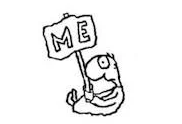
I pray I never in my whole life ever betray my younger self the way that Michael Leunig, anti-vaxxer and miserable self-centered anti-phone anti-youth shithead boomer stereotype has betrayed the Michael Leunig in that video.
Game Pile: BLOOD
The Attack of the Dead Men
During World War 1, German Command received a message that their offensive had failed and been routed by a charge of zombies.
Content Warning: World War I, descriptions of gas weapons
October Shirt II: Inside Eyes
A thousand eyes
Open inside
To grant me sight to see the end
A thousand eyes
The curse of the wise
Into the madness I descend
Here’s the design:

And here the design is on our friendly gormless supposedly unisex Redbubble model:
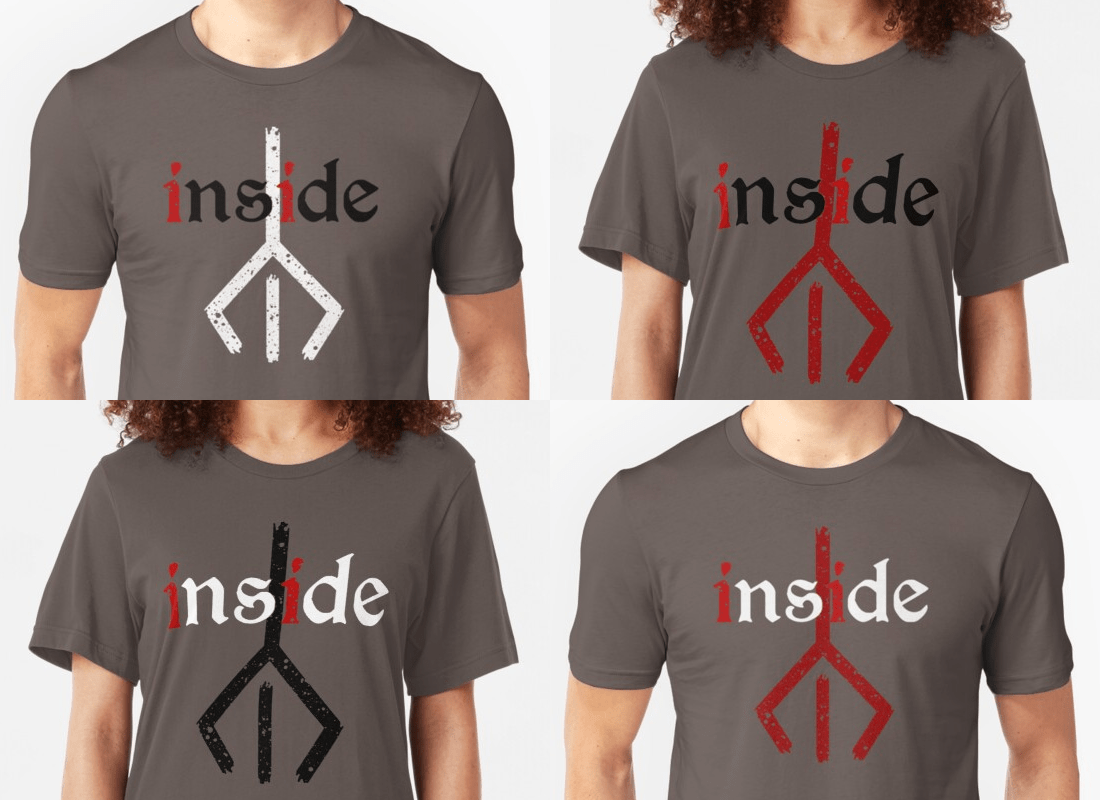
And here’s the design being modelled by the Teepublic ghost:

Random NPC Name List
Hey, I made this to put in a little booklet to sell at the con table, but hey, you can have it here, the whole table, as is.
Story Pile: Jigsaw
Content Warning: Due to the nature of this movie, I’m not using pictures for this one. Not because it’s super horrifying, just because it’s not really very important. There’s some medical horror in this one, and a lot of gory fake dead bodies mangled up in messy ways. I’m also not really talking about spoilers beyond ‘there is a twist,’ which is sort of du jour for horror movies in the Saw franchise.
With that in mind, we now begin the presentation.
Just how good can this movie be?
Making The Worst People
Content Warning: I’m going to START at Hitler and we’re going downhill from there. Here’s a picture so the thumbnail’s not fucked up. Here’s an escape link.

3.5 Memories: The Kaorti
Now, while I may be on the record saying that Dungeons & Dragons can do horror scenarios, doesn’t mean I necessarily agree with the way that the default books angled towards horror. One can point to the ‘mature’ Book of Vile Darkness (more like vile dorkness, boom, gottem) that tries to be shocking and edgy and it’s just kind of insulting and basic. But the BoVD wasn’t the only book of its type that tried to be creepy and horrifying, nor was it one that strived to be mature.
For example, the Fiend Folio is the only book I own with nipples.
Here, check it.
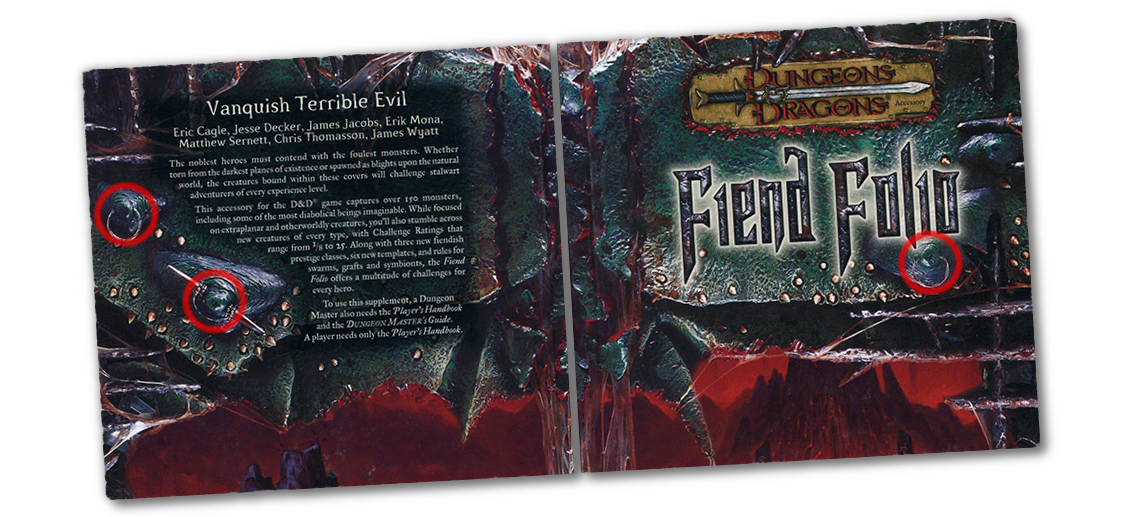
After this point I suppose it only bears to mention: Content warning, creepy monsters and horror imagery after this point.
This book is also trying to cover a lot of bases, with some artists getting quite a lot of work which I feel, though can’t say for sure, is a product of some artists being very productive in a short period of time and that being used by the art director. Like Thom M Baxa, who produced a bunch of work in this book which is meant to represent a lot of different things but mostly just seems to represent Just Thom M Baxa’s work.
Continue Reading →Game Pile: Bloodborne
What is there to say about this, the longest night?
Bloodborne, for those unfamiliar with it, is a 2015 PS4 exclusive videogame by From software, the makers of Demon and Dark Souls, and joins those games as part of the genre we hamfistedly call ‘Soulsborne’ games, because videogames are a space where it’s very important to constantly reinforce brand loyalty, I guess.
The game starts with you as a hapless person dropped context-free into some space or other whereupon a game kills you repeatedly and gives you infinite chances to avoid dying again. It is largely considered to be one of the greatest videogames ever made, which doesn’t seem to be wrong per se but as I played it, seemed more and more to be an insult to videogames in general as a medium.
I took notes as I played the game, which is a transformative thing with a From software game. The experience of these games often melts away so you don’t really know – you don’t know – how many times you try things, how difficult a game experience is until you really look at it in a numerical context. I did, so I have a very reasonable measure of how much of my life I was spending on this game, and whether or not the progress I was making made me feel good enough to merit that exchange. It’s very easy when you don’t quantify these experiences to think a game is ‘hard’ and just let that one word cover all your sins, as opposed to having clear information about how many days of effort it took you to deal with boss monsters that, amongst other things, do behave semi-randomly.
I also haven’t finished this game at this point. I got the game in January of 2017, and haven’t finished it as of October 2019. I don’t think this colours my opinion of the game at all, and I think it’s actually very important to look at the game from this position, rather than from the perspective of someone who having finished the game, is able to dismiss all the time spent as being ‘worth it’ in the end.
Continue Reading →FOYMO
Let me tell you about one of my little fears.
It’s a little fear, not because it’s small to me. It can be all consuming, to me. But it’s a little fear because it’s a sin that can be measured in dollars and cents.
I sell games. I sell my writing, too, on this blog, here, on patreon and still don’t know why you pay for it but I’m so grateful. But I sell games, and those games are typically made out of cards that are printed and I hand them to people and they give me some money and they go away. Overwhelmingly, our sales are face to face, in conventions, and to people who talk to me and buy the games based on talking to me.
I am scared, so scared, that one day someone is going to come to me, having bought the game, and say ‘Yeah, you know what, this game is really bad, and you wasted my time and money.‘
Everyone’s so nice. Even the responses we’ve gotten about some of our games that don’t work is it’s too easy for me, or we didn’t use that rule, or he outgrew the game quickly. These are the little cuts, the little things that make me wince because I feel like I did someone wrong. Like I guided them into a bad purchase. And I fear that everyone who bought a game, or who I sent a free copy of the game, is just quietly being polite.
It paralyses me in improving and upgrading our games, too. I want to revise LFG and Burning Daylight and even Middleware, but I feel like doing anything to make the games that are already purchased ‘wrong’ would be a sort of act of violence against those people who trusted me with their money and time. I am ultimately afraid of making my game better so the people who bought the game before hand are left with a version of the game that is missing something.
I have a Fear Of You Missing Out.
The Cult Of The Decapitated
This year, I had reason to go deep on the book Man, Play And Games by Roger Caillois, and I have made my notes about it very public including exasperation at the kind of person who’d write such things. Wanting to know more about Caillois however pulled me into reading about his circle of friends, including the philosopher Georges Bataille and strange woman-behind-the-culture Colette Peignot, aka Laure.
Time to time I’ve mentioned their ‘cult of skulldicks,’ which is funny, but I think it’s worth giving at least a briefest overview of this quietly chilling group of extremely serious people who at one point, were going to walk out into the woods and kill themselves.
Let’s talk about Acéphale.
Being The Monster: 5 Horrible 4e Heroes
Everyone I know has some hypothetical interest at the very least in playing a hot monster in their local tabletop game. I am willing to recognise that this is a selection bias, possibly due to the overwhelming presence of the queer monsterfuckers in my social circle, but the long and short of it is that I know people who regard the Monster Manual as less like a threat and more like Tinder.
The problem with making monstrous characters in most D&D games is that all the monsters you might want to be are gated behind a lot of rules baggage, like the hellscape of imbalanced garbage that is Savage Species back in 3rd edition. But what if in this season of spook, you want to make a monstrous character and just get rolling in my edition of choice? Here then are five spooky characters you can play from level 1 that let you get in the spirit of the season without needing to jump through a dozen hoops.
Story Pile: Expectable Dreads
I watched a bunch of different horror stuff this year, in part because I actually think I kind of like the genre, but also because it’s a place that does a bunch of interesting weird stuff. Horror Youtube is really bad, Horror Critical Youtube is pretty good (or maybe I just mean Nyxfears). Watching this media can be, at times, a guide, a sort of mental sabot, that encourages you to think and present your thoughts in a similar format, to make everything a five minute mention.
This impulse left me spending words on things I didn’t really care about enough to talk too long about. Particularly, though, what I found was a common thread of introducing the wrong horrors into these stories, a point at which I checked out, and knew that effectively, a content warning would just be the overwhelming character of whatever I had to say. It wasn’t that seeing worms implanted in someone’s body or the tearing of a man’s face off that bothered me, no, I was signed up for that.
Here then, four horror movies and series that I kind of wanted to talk about but which introduced something that made them suck.
Content warning for mentions of sexual assault, transphobia, incest, and pedophilia, and spoilers for American Horror Story, Don’t Breathe, Rings, and A Cure For Wellness.
The Wandering Want
You procrastinate much?
I understand there’s a body of people around me who have problems with attention deficit, and the connected problem of hyperfocus. This post is going to talk about how I experience procrastination, which is going to use terms that may sound like I’m trying to talk to you, or talk to your experience, and I want to be clear that I’m not and I don’t think I’m in a position to do so. Okay? If this is useful or whatever, great, but don’t presume I’m applying universal truths to people who already have reasons to interrogate their own focus behaviours.
Anyway, if you procrastinate, there’s probably a really good reason.
If you find yourself with your project, engaging with one part of it, then not wanting to do the rest of it, it’s possible to frame this in your mind as a kind of procrastination, to think of it in terms of an incompleted project because you hvaen’t ‘gotten around to’ finishing up a roster or completing a component of it. You might find yourself setting aside time to work on a project, but instead find yourself working on other things, doing housework, cleaning up your laundry, and at some point, you may find yourself, arms in the sink, doing washing up and asking yourself:
Wait.
Why is washing up more fun than what I was meant to be doing?

This is something I talk to my students about. The type of work they do is a single big project, something they spend the whole semester exploring, then defining, then making, and it’s about building skills for the specific things they want to do, and show they can follow a project through. There’s a focus on responding to feedback, and part of that feedback that they seem to keep missing (until I tell them to look for it) is their own emotional responses to their work.
If you keep putting a project off, if you keep shifting focus away from it, is it possible it’s not something you actually want to do?
If you find yourself not wanting to do the project, why do you not just stop? What’s stopping you? Do you instead want to do less of it? Do you want to not have to do some part of it?
I am a big advocate for finishing things, especially creative things. It is a big deal to me that I encourage people to get around to finishing those things they want to work on, because it’s very rewarding, and also because if you’ve never done it before, you don’t know if you can find it addictive. But a part of finishing a project is starting a project that you can finish, and it’s entirely possible that you’ve started something you don’t want to work on right now, and that’s entirely okay.
There’s a host of psychological studies about the value of procrastination and the ability to manage your hind brain and that’s all interesting, but more than that, for now, what I want you to bear in mind when you find yourself procrasting is you don’t want to work on that thing right now, and that’s okay.
October Shirt I: Hunter’s Mark
This month, our shirt design is a little bloody…
Dangling, upside-down rune etched in one’s mind. Symbol of a hunter. By focusing one’s thoughts on this rune, a hunter loses all Blood Echoes, but awakens afresh, as if it were all just a bad dream.
Here we are
in the dark
Knocking on the hunter’s mark
Here’s the design:
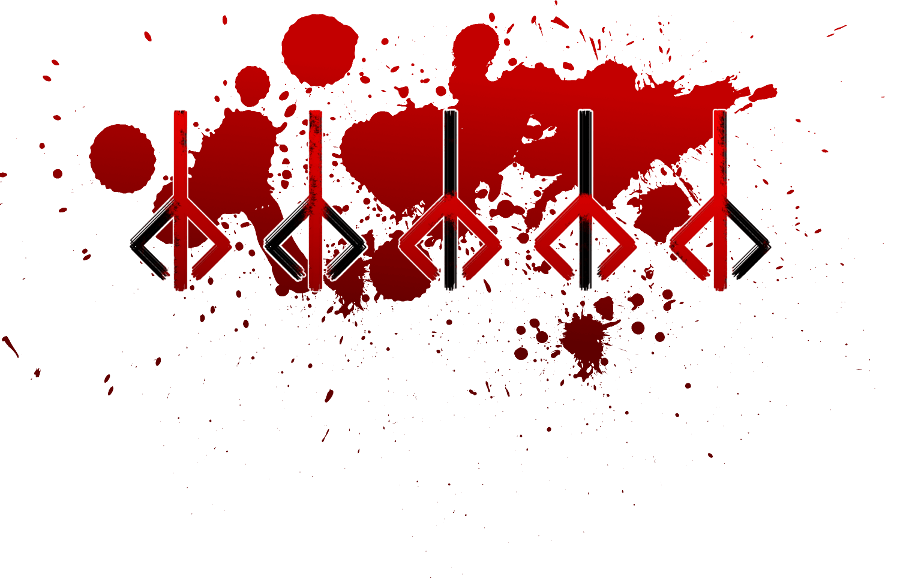 And here the design is on our friendly gormless supposedly unisex Redbubble model:
And here the design is on our friendly gormless supposedly unisex Redbubble model:
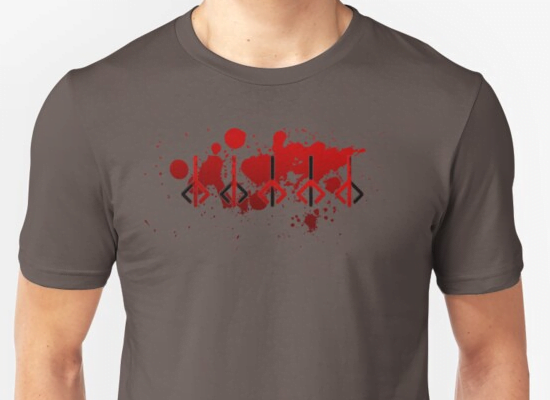
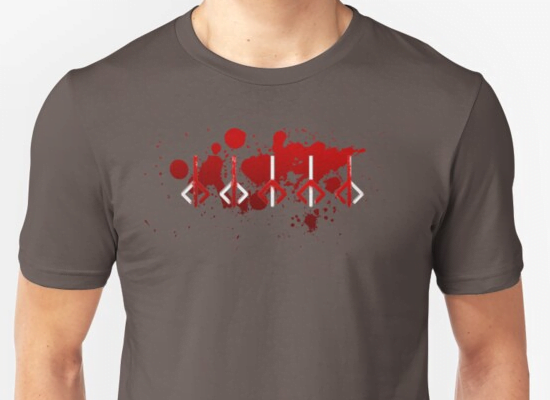
And here’s the design being modelled by the Teepublic ghost:

Game Pile: Tides of Madness
Tides of Madness is a drafting game for two players by Portal Games that retails around $15. In the interest of not just being mean to this game, it’s made of very pretty parts. Each card is fully illustrated in postcard orientation with a full-art depiction of some generic Lovecraftian thing. Additionally, each card has a set it’s from, and a mechanic that says what set it rewards. This is a basic kind of set collection mechanic, where you get X, but it rewards Y. This divides your incentives, and you’re limited you to five choices each round, presenting the game’s tension.
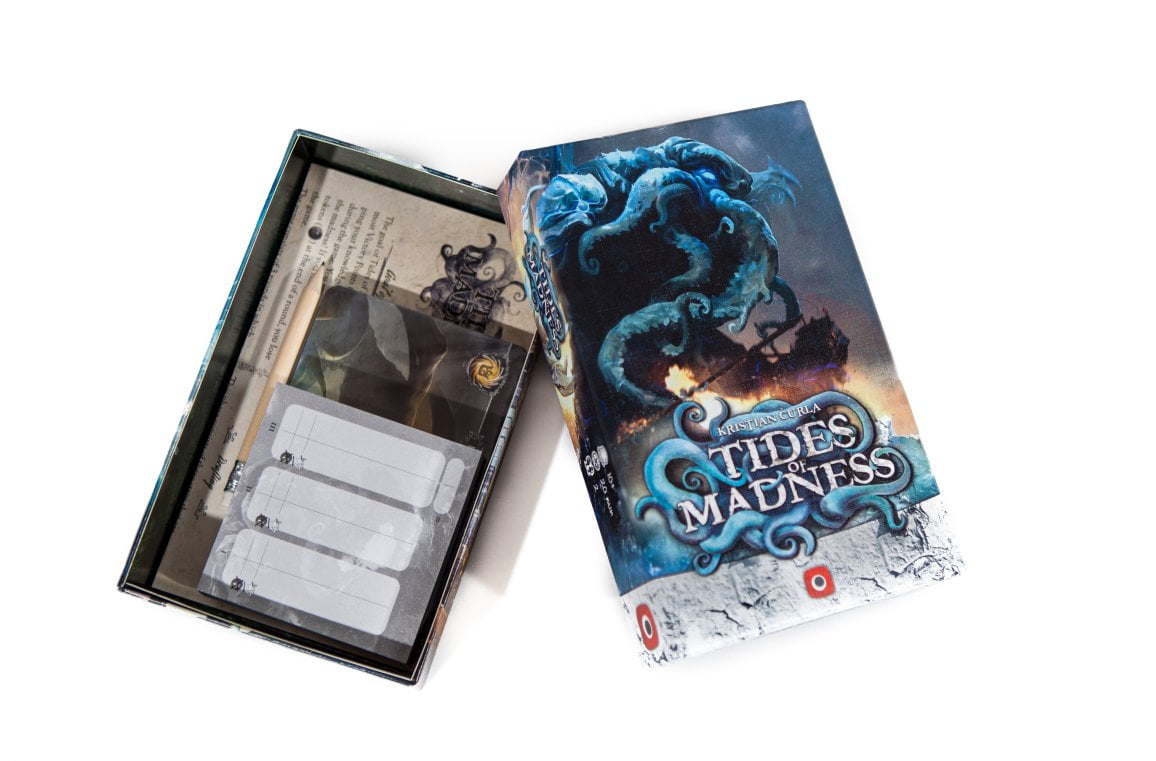
I am personally pretty pleased by the challenge of making a game with such deliberately narrow constraints. I’ve made other games with eighteen cards, including drafting games, and conceptually, it’s an exciting design challenge. It’s not like ‘X feeds Y’ is a bad game mechanic, asking you to track the pieces. The puzzle then is what to pick, to force your opponent’s hand and deny them potential points. Of course, a problem that follows there is how obviously separated or clearly presented those pieces are. The set symbols are ambiguous and small, making it hard to keep tracking them during the game.
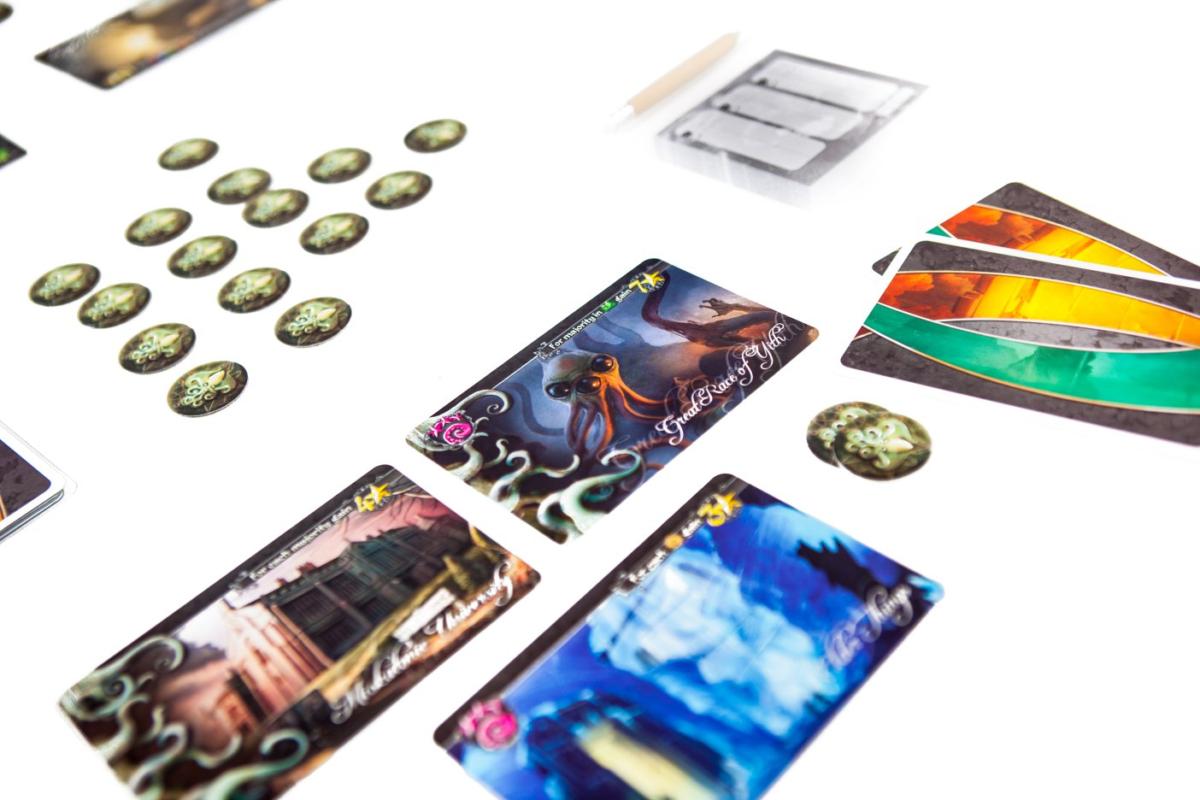
The first time I played this game, my opponent and I immediately complained about its generic feeling. Not just the Lovecraftian monsters theme – though you can bet I’ve got views on how that’s handled. We felt that all but three cards were very obviously just permutations of cards in other sets. When the art is so indulgent and the cards so large, this lack of depth stands out. This game retails for very little so it can seem reasonable to be charitable about its failings. I’m not feeling charitable, though, and you should buy my cheap drafting games instead, like Winston’s Archive.
I drowned
Content Warning: Drowning.
3.5 Memories: Psionics
Maaan, this system was cool.
Okay, so it’s twenty years old or something so I’m assuming you don’t really know what this was or how it worked. Psionics was one of those things that D&D 3.5 seemed to pick up because it was in 3rd edition and there was something similarly back in 2ed and then going back. It was never something the rules prominently featured, and was always meant to be its own little contained system that ‘couldn’t work the way that spells worked. The older systems, back in 2ed used ‘power points’ instead of ‘spell slots,’ you know, one of your rudimentary mana systems.
These required rules, coupled with the way they were sequestered meant that the Psionics systems got handed off into a small number of books, which were focus work by a small number of developers who not only really cared about them, but weren’t competing with anyone about it, like the core rules’ Druid, Cleric, Wizard and Sorcerer problems were.
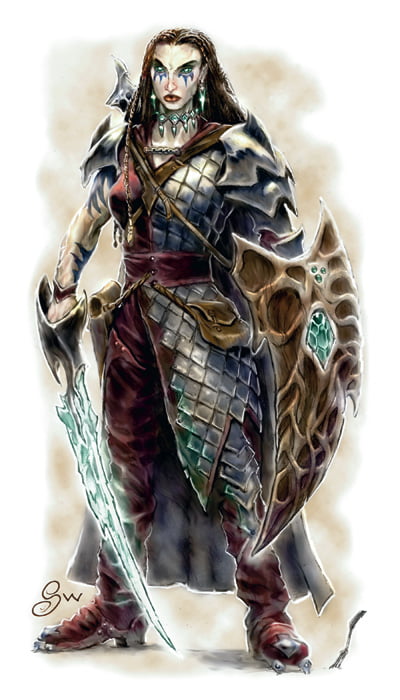
The result is that the Psionics system is made up of a smaller number of powers that have to be flexible, because they just weren’t going to get a lot of different psionic powers the way that every different version of a fireball got to have its own fancy special effect.
It also meant the psionic powers had to be designed to scale much better than the spell system; rather than the tight restrictions of spell slots that force you to wind up collecting a large number of choices, and be aware of all of them as the best least tool for any job, you instead had the powers that you could do, and the choices were made at use. You could spend points to make your powers scale, and you could even choose the way they scaled.
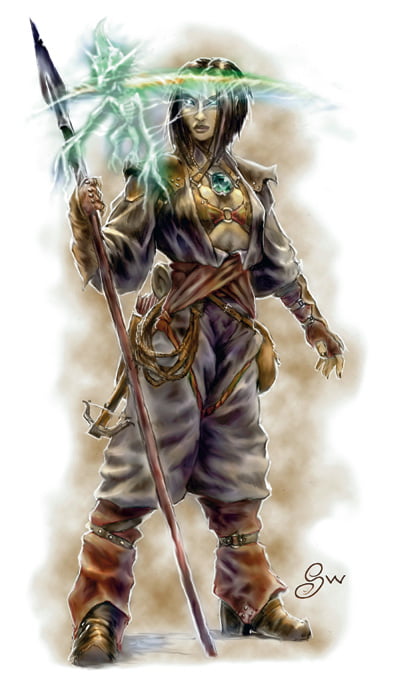
That meant that yes, you still had fiddly spells, but you chose how fiddly they were, how fiddly they could get. You could pick your powers to get a wide variety of oddball stuff, or you could focus on a consistent theme, using your power choices to make one power you were absolutely great at, and small utility powers to go along with it.
There was something to the aesthetic of it, too. Rather than your typical wizards and robes and swirling lights, Psionics played in a realm that was more purple and crystals, with a sort of Cthuluhoid Lovecraftian horror to the enemies. Rather than drawing on the idea of old lore and ancient history, of things written in books, the storytelling of the psionic character was more tied into really primal knowledge, things that were born out by doing rather than learning.
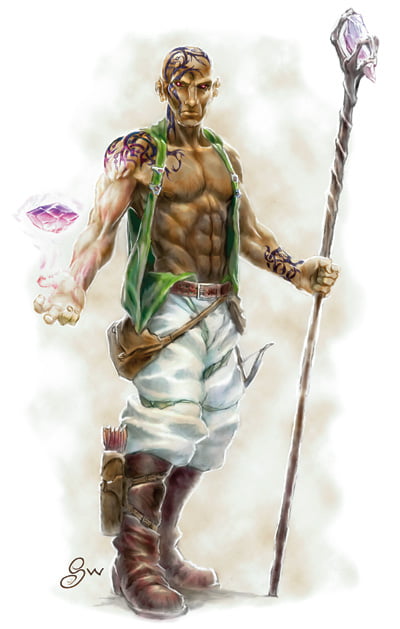
This still put the books in some odd places, of course; mechanically, there still needed to be wands and scrolls, because those were considered essential parts of balancing the needs of a flexible spellcaster, so there are Dorjes and Power Stones (or ‘sticks and stones’ as they were known). There were psionic dragons, because of course you need dragons, and their gimmick was, well, they’re dragons, but they’re psychic.
Yet when I think back on this system, a thing that really sticks with me is how in 3.5, there were just so many builds you could make for psionic characters that weren’t constrained the way that wizards and clerics were. You could afford to lose a caster level or two, you could pick up other effects to build on what you had. You could share spellcasting skills between different psionic classes, and there were interesting, oddball prestige classes that gave you a niche, interesting way to craft your character.
Normally when I think back on 3.5, there’s a pretty clear hierarchy system that kicks in. Fighters form a sort of basement where everything that’s worse than it is seen as really hosed. Then there’s the crew of weird classes that aren’t bad for any specific reason, but because they have a niche that usually can be replaced by a spell from a wizard. Then there’s the really good renewable resource types, the powerful melee hitters, the prestige class complex builds, and then there’s the spellcasters, and then just at the bottom end of the spellcasters there’s the rogue and some gish, I guess. It’s a complex space and most of them, the best thing you can do is one thing.
But when it came to psionics – classes that mostly sacrificed variety of effects for flexibility of application – there were just so many different ways to build, just based on the powers you took.
Kinda preceded the Book of Nine Swords, too, and formed the foundation for the way 4ed worked.
Huh.
Funny that.
MTG: Jeskai Catgirls
Okay, Modern is a silly place. This is not going to be about a cutting edge deck. This is the kind of deck I like to write about and play, because it’s not trying to be about playing in a specific metagame environment, about being in a tournament space. It’s a combo deck, but it looks a bit like a control deck, and it uses an interaction that’s probably too slow for standard, but also gets to do stuff I tend to enjoy – flickering permanents and making memes.
Anyway, here’s the basic gimmick.
There’s this card, Felidar Guardian. There’s this other card, Saheeli Rai. Together they form a combo that generates an infinite number of hasty artifact cats, or rather, an arbitary large number of hasty artifact cats, so you can stop when you want. It differs from a lot of combos in that the cards are actually good on their own, with Saheeli being a planeswalker that scries through your deck to find things, and the Felidar Guardian resetting a lot of possible permanents.
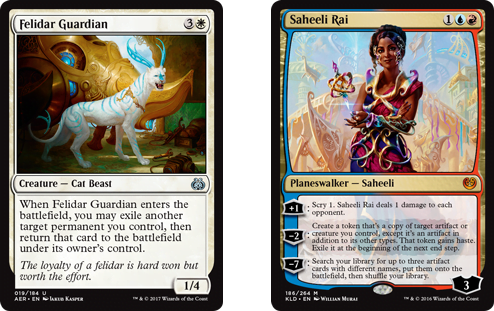
Now, I like Felidar Guardian decks, because I like flickering things. I like when my value creatures give me more value, and I’ve liked that since [mtg_card]Astral Slide[/mtg_card], a deck that isn’t actually good anywhere any more, but let’s not get bogged down in that. The thing with this combo, known as Cat Lady for a while, was that it was pretty powerful in Standard (so much so it got a sort-of emergency ban?), and my love of durdling and flickering creatures is kind of weak when compared to ‘just winning the god damn game out of nowhere.’
Also, flickering creatures with the Felidar Guardian is fine, but also not particularly impressive these days. You want stuff that’s already on the field with the Guardian around, and flickering wants to be cheap, and so it’s not good for recurring on the battlefield, and so on. Still, War of the Spark gave us a bunch of planeswalkers that tick down and you can use the Guardian to flicker a bunch of them. Funnily enough, in these colours, there are a few really good Planeswalkers for this, and they seem to all be girls.
And thus, from Cat Lady, we now have:
[d title=”Modern Jeskai Catgirls, October 2019″ style=”embedded”]Creatures
4 Felidar Guardian
4 Wall of Omens
Planeswalkers
1 Chandra, Acolyte of Flame
4 Saheeli Rai
3 Narset, Parter of Veils
1 The Wanderer
Spells
4 Lightning Helix
4 Lightning Bolt
4 Remand
4 Sleight of Hand
4 Hallowed Fountain
4 Serum Visions
Lands
4 Sacred Foundry
2 Glacial Fortress
2 Clifftop Retreat
4 Steam Vents
2 Plains
2 Island
1 Mountain
2 Sulfur Falls[/d]
This deck could be improved massively with the addition of [mtg_card]Snapcaster Mage[/mtg_card], because at its root it is a 1-2 mana spell based control deck that wants to dig through a deck and win reasonably quickly. [mtg_card]Chandra, Acolyte of Flame[/mtg_card] is a pretty decent kinda-Snapcaster who has supplied some games with an extra few points of damage, but it’s very clear to me the difference between 3 mana and 2.
You make lands and planeswalkers, protect yourself, slow your opponent down, dig for cards, kill threats, then find Saheeli or a Guardian or whichever you don’t already have, then win the game immediately.
It’s not great, but it is fun!
Story Pile: Goosebumps
The existence of this movie is in a lot of ways a pre-built punchline. I mean, Goosebumps is one of those book series that people in their adult life seem to go back to to complain about them being dumb or basic or whatever, and this movie, which is aimed as being Big Spookums for the I’m Old Enough For M Movies scene of twelve year olds, is a Jack Black movie. Jack Black has made a lot of movies that are bad, he has made a lot of songs that are bad, he has almost made a varnished kind of badness his business, and he even specialises in representing himself as someone you really hope leaves soon.
Everything about this movie is lined up to tell you that this movie is going to suck ass…
and it doesn’t.
Some mild spoilers for the movie as follows.
Five Reasons You Should Try Running 4e
Typically when these edition conversations come up, I come at it with a certain kind of defensiveness. This is in part conciliatory – after all, I don’t think the conversation is useful if it’s about whether or not you should play 5e or 4e (or 3e, or Pathfinder, or whatever). It’s not useful, because I have a straightforward answer that I think 4e is better than all of those other games, and I don’t care about hearing about those other games at all.
I know, it’s so unreasonable of me. I just don’t care.
Nonetheless, I often get asked afterwards, ‘hey, would you suggest I try 4e?’ and I usually say something to the effect of ‘hey, I don’t know, why not.’ This is in part because organising a tabletop game is a big pain in the ass. If I’m suggesting you branch out, is it really best to suggest you start by trying 4e, when there’s other, less difficult games to get rolling on, that will broaden your palate and give you a better appreciation for more games, and maybe even give some money to a deserving soul. Is it better to suggest you try 4e D&D than try Dog Bear or Brinkwood or Monster of the Week?
But let’s set that aside for now. Let’s assume you’re curious about a D&D game and are deciding between your options. Alright then, quick and dirty, here’s five reasons why you should try 4ed:
5. It’s Cheap
Perhaps thanks to its reputation and perhaps thanks to being a ‘dead’ game, 4th Edition D&D’s core rulebooks can be had for $10 each in pdf form, giving you a total of $30 to get started. The 5th edition Player’s Handbook is $50, and isn’t even all the resources you’ll need. You could buy the 3.5 PHB for the same $10, but I will point out, that game is really bad and falls apart when you look at it too hard. 4e, on the other hand, works, and that’s what we’re talking about here, geeze.
4. It’s Convenient
Hey, do you like homework? I don’t like homework. Other editions of D&D are set in settings with really specific tones and rules about how the world works, so if you make a character thinking about their flavour first, you have to double check rules to see if that’s true. This can be a real pain in the ass if you want to play something like a cleric or a druid and need to know how magic and your powers interact with your worldview.
4ed D&D doesn’t do that! There’s no pre-established setting you have to learn about while you’re just finding your feet. The world could be dense and rich in lore, it could be an existing story space you like, you could just use it to jam in another setting if you want, because it’s mainly concerned with making sure things work and not being too fussed about how.
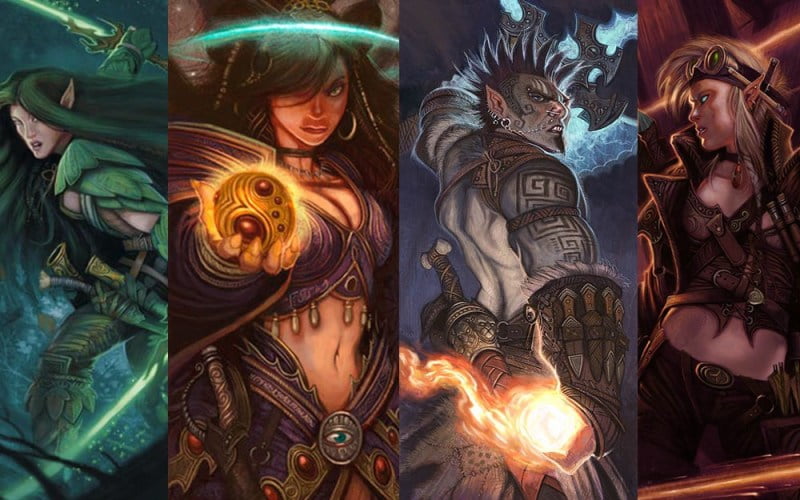
3. It Works Great Online!
The 4ed resource set is one where the biggest complaint people have about its primary mechanical axis (the miniatures and tabletop space) is stuff that a lot of online tabletop spaces already cover. If you use Roll20 or Tabletop Simulator to run your game, you won’t need to do anything fancy to get the resources required to set up or play, because all those assets are easily googled and slapped on the tabletop conveniently.
This means that if you have a problem with getting players to the table, like people have commitments at home and the like, maybe you have a slot in your normal gaming group for a 4e game that lives in those downtime weeks.
2. It’s Fast
Combat in Dungeons and Dragons games is pretty slow, no matter what; there’s always some friction lost to checking initiative and turns and the round of the combat it’s in, and people considering their options and that’s just there. 4ed D&D combat is still about as slow as the editions around it, but 4ed does what it can to push that friction down.
When you’re making characters, roles let players stay out of each other’s ways and when you’re playing, roles let you get a clear idea of what your allies might need. What’s more, it’s pretty easy to make a character who, at level 1 works pretty much fine, and all your standard stuff you need to do your character’s job is guaranteed.
1. It’s Amazingly Easy To Run
The 4ed encounter builder is so robust that you can literally pick monsters at random, and there are even online resources to do that for you, and you will have your encounters pretty much put together. You can even use this to give you an explanation for the session – these four random monsters are in this level 1 encounter? Okay, why are they working together?
The back end of 4e D&D is really, really solid. If you’ve never run a game and want to try it out, 4e D&D is one of the systems that I hold out as a system that knows it has to explain things to you when you get started, and it puts good, useful tools in your hand.
So there!
Serial Killer Stories
This year I tried out watching Dexter, Hannibal and Mindhunters, different series focused on media about serial killers. I didn’t find anything that interesting to talk about in them. Maybe if I was a much better resource, more aware than I am, about the topic of autism, I might be able to draw something out of how all three series are built around characters that are either subtly or explicitly autistic, and then how both series completely fuck that up. Mindhunters was mostly just boring, contrasting interviews with tedious office humdrum and the academic difficulty of getting a real historical book written. Whatever.
The others, the more fictionalised serial killer stuff, and various other movies I’ve tried this year, those are different beasts. Why these kind of stories happen, like why are there series that last for years about these very short-fuse ideas. Why are they appealing, what they do to lure people in, what connects people to the diegesis. I wonder sometimes about it, if the reason I can sort of watch these series without really feeling anything about them. I think the main feeling these shows left me with, as I sat there with a fingertip on the fast forward button, is boredom.
Sometimes it’s a matter of scale. Like, Dexter is a series where literally a new serial killer’s activity kicks around basically every week, and the people involved are trying to avoid the involvement of federal authorities to try and deal with it, while simultaneously complaining that they don’t have the time or resources to take care of these problems which, again, include weekly serial killers. Sometimes it’s a matter of the conception of the things, the self-seriousness of them, the idea that the FBI employs ‘profilers,’ specialists who walk into a crime scene and it’s their job to draw together all the information in a sort of psychic trance. That that’s not everyone’s job, and there aren’t whiteboards of information where people put together whole slabs of possible provable things about motivation and agency.

I think my favourite ridiculous thing about Hannibal is that there are numerous cases where there’s nothing in the case that gets solved that is in any way helped by Will Graham’s supposed prowess. It’s just a dude who shows up at a scene, gets traumatised, and then the serial killers get themselves caught on their own. In Dexter it’s the same deal, where the fact that the police station is basically an overworked office with four people in it. In each case, we’re meant to be watching these impressive interplays of the master inhuman, Lecter in one and Dexter in the other, but it’s just all stagecraft.
There’s a sort of twee titillation about both of them, a sort of almost hum-drum tedious shockingness. Like there’s a really good special effects department pumping out bulk props and able to make fake blood by the gallon, and people are tunining in for these things that are long on mood built around the ‘complex’ idea of What If People Around You Were Bad? How do you build tension around these questions of being surrounded by people who do bad things, who might be quite bad, but are capable of functioning as normal people?
There’s this funny kind of alienation in the horror of it. This conception of ‘what if your every day reality had something horrifying and bad in it!’ which kind of hilariously… banal. It’s a lot like the idea behind The Walking Dead, where these scenarios that are meant to be horrifying have to come at that horror from a frame of total safety. Like there needs to be a sort of middle class, mid-thirties yawning wannabe prepper-ness to it.
These stories want evil to be something that’s both incarnate and alien, human forms given to the fears for their safety. I mean I still watch this stupid shit, but it’s all a sort of suspense porn. It’s about feeling tense and then shocked, even when there’s just nothing surprising about ‘oh, then this other major character will die.’ They’re ghost trains for adults with really high production values, and the things they can say are spooky are things like people who struggle with dissociation and lost time. You tune in to see if someone you like is going to get out alive.
They’re also, almost uniformly, disappointing in the end.
I’m sure there’s some reason for that.
Game Pile: Time Fcuk
You’re walking down the street, when a cardboard box opens, and you step out. You immediately impress upon yourself that you are, yes, you, and they need you to get into the box because that’s how the time travel that brought them here works, that you will appreciate it, that you will enjoy it, that you will understand such amazing things when you get in the box.
Get in the box.
GET IN THE GODDAMN BOX.

Time Fcuk is a game about time travel and being in a box.
But First…
There is a joy in horror.
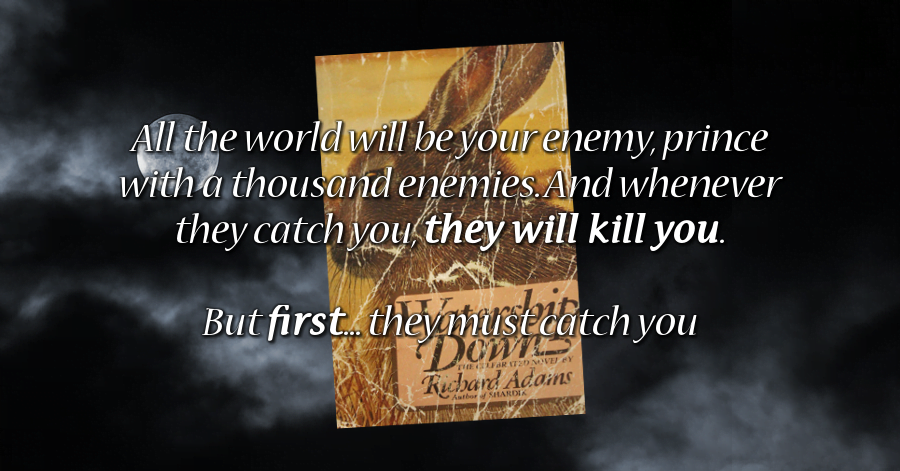
There’s a truth to it that horror is a space that draws the marginalised. There are a variety of reasons for it, many socioeconomic, many infrastructural, and almost none that actually have anything to do with demonic forces or actual witches, no matter what Alex Jones types want you to think. There’s a not-insubstantial body of people for whom horror in fiction and media directly relates to and catalogues horror in their own lives.
3.5 Memories: Heroes of Horror
When you sit down to play a game with your friends, you are ultimately looking to have an experience. That experience can be built around so many feelings, so many ideas, and it is just as valid an experience to seek out the tension and catharsis of a horror scenario as any other. The horror campaign, the macabre fantasy, the tangle of feelings you get when you find yourself pressed in the thorns and consider how much you’d give to just escape, even if it means leaving behind a little of your soul – this is absolutely something you can do in tabletop games.
It’s not even at odds with Dungeons & Dragons’ vision of heroic fantasy, which we can argue about, or wait, no, we can’t argue about it, because I find having to define the narrative parameters of a heroic fantasy or really deal with people who want to try and define the ‘genre’ of a game that’s as broad and flexible as D&D to be a task more akin to pulling teeth than having fun. Accept then that it is entirely possible to run a horror game using Dungeons & Dragons, because even if it’s not to your standards of horror doesn’t mean it doesn’t deserve to wear the genre label.
And Wizards of The Coast recognised it too, releasing the 2005 supplement for D&D3.5, Heroes Of Horror.
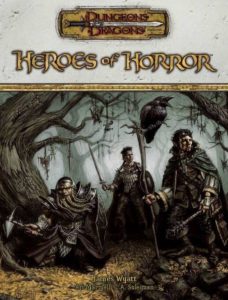
This book is, let’s say it reaches the lofty purchase of fine, I guess. I’m not wild about the content it offers (in no small part because my players have been horrified by things I made without any such guidance), but I’m also not against what it’s doing for the most part. Particularly nice is that the book contains an attempt to discuss player boundaries and emotional needs, even if it’s a very surface, a very 2005 discussion of those boundaries. I was going to give this book a treatment, only to find I already did a thread on it, and then saw how that thread kind of cooked away into just making fun of one thing in the book.
Even while the book is a thorough examination of a theme space, it’s not all one way of looking at it. There’s talk about player options, about how to handle ideas of tainted powers, kind of a Moorecocky thing. There’s some monsters meant to be more horrifying, there’s some discussion about the use of the inexorable, about the notion of the destruction or opposition of hope itself as component of horror. There’s also some horror scenarios, which I’ll admit I don’t find very engaging because they start at ‘murder clown mind-controlling orphans,’ and I don’t really need any kind of special rules to treat clowns as kill-on-sight targets in games. They’re up there with viziers.
Nonetheless, this is a 3.5 book and what that means is at least somewhere, you’re going to find a big list. In this, the list is a gigantic, 100 entry list of what it calls Creepy Effects. These are meant to be things you can dot into the game to give players a feeling of something unsettling being afoot.
There are three problems with this list. The first is the kinda fucked-up time issue; some of the list’s things can be singular moments, abrupt and dramatic arrests in the vision they have of normal – all the wildlife in an area falling silent to no effect, for example. Some of them are long-term problems, like fiding a persistent object you were sure you disposed of. These events aren’t really comparable – one is best when it comes out of nowhere, the other requires regular poking and prodding to make a repeated effect.
The second problem with the list is how many of these ‘creepy’ things are in fact very ordinary. One creepy happening is meeting a person who has a voice like an adult, but are as tall as a child. That is to say, meeting somone short. Another is a player hears something that none of the other players hear, which is a really common real-world experience, not to mention hearing voices or smelling smells nobody else notices. I get it, it’s horrifying to experience those things if you’ve never had to deal with doubting your own perceptions, but for people who have experienced that, it’s just kinda a reminder of how precious the writer must be. There’s also a bonus point here: in a world where there are Sending spells and Psionics, how is it weird to hear a voice? The real trick is trying to work out who sent the messages.
Finally, the third problem is this table ends on the entry: One Word: Fog, which made me laugh so hard it broke all chance this game had to ever act like it was going to lead to spooky games ever again.
October Is… Dread Month!
For the month of October, my Story Pile, Game Pile and general posting will be wound around the theme of dread month. And why dread? Because I needed a word that didn’t exclude things.
It’s not a horror month; criminal history and real world cult stuff isn’t really horror. It’s not a death month, because, well, death isn’t actually a universal element to the things that creep us out. And sometimes, there are things that are the aesthetic of ghosts and ghouls and scary things but isn’t actually very scary, because it’s being used to some other end.
This isn’t really about Halloween per se, though I’m going to ues it as an excuse. Halloween isn’t a thing here, not really – people trick or treat in the hopes of finding anyone who might have treats and the one or two kids that turn up at our place who actually are trick or treating, we give them all the candy. But Halloween does mean that y’all have been rocking haunted twitter avatars since early September, and who am I to waste an opportunity?
And so this month, we’re going to have creepy stuff, horrible stuff, threatening stuff and critical self-examination of my relationship to fear and, you know, maybe some of that cult stuff. And I’ll probably mention Hitler!